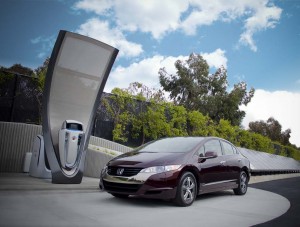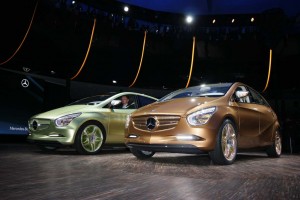
Honda has set up a solar-powered hydrogen refueling station near Los Angeles for the maker's FCX Clarity hydrogen vehicle.
Editor’s Note: We hear a lot about battery power these days, some proponents insists that hybrids, plug-ins and battery-electric vehicles will be the only way to achieve the tough new mileage standards set for 2016 and 2025. Yet, not everyone is betting on batteries. There are plenty of proponents who believe the real answer is hydrogen, the most abundant element in the universe and a gas that could truly achieve zero-emission driving.
Among the true believers is Peter Hoffmann, publisher of the Hydrogen and Fuel Cell Letter, and author of the new book, “Tomorrow’s Energy: Hydrogen, Fuel Cells, and the Prospects for a Cleaner Planet.” TheDetroitBureau.com has this excerpt from that new book, the chapter titled, Terra Transport: Hydrogen for Cars, Buses, Bikes, and Boats. To read more, Click Here for a link to Amazon.com.
“Basically, we can mass produce these now. We are waiting for the infrastructure to catch up.”
That’s what Kazuaki Umezu, the head of Honda’s New Model Center, told reporters who in mid-2008 had come to cover a momentous event in the annals of hydrogen and fuel cell technology: the launch of the Japanese carmaker’s—and the world’s—first dedicated fuel cell car assembly plant in Takanezawa, a small town of some 30,000 residents about 80 miles north of Tokyo.

Mercedes is also looking at opportunities for Plug-in Hybrid and Fuel Cell Vehicle technology, used in its prototypes, the E-Cell Plus and the F-Cell.
Automotive assembly plants typically churn out hundreds of thousands, or millions, of cars, so the new plant is a modest affair and probably represents a learning tool as much as anything else. Its launch task was to produce Honda’s most polished, widely admired fuel cell passenger car, the Honda FCX Clarity. The plant’s dedicated fuel cell vehicle assembly line includes unique operations not normally found in these types of plants, such as equipment for installing the fuel cell stack, manufactured at another nearby facility, Honda Engineering Co., in Haga-machi, and of the high-pressure compressed gaseous hydrogen fuel tank
The infrastructure issue—where and how do we get the massive hydrogen refueling capacity for the expected masses of hydrogen cars—remains a continuing concern in the United States, Europe, and Japan four years later but with some hope of resolution—did not overly worry Umezu’s boss, Honda’s president Takeo Fukui (he was succeeded in early 2009 by Takanobu Ito). He told another reporter that about a hundred years ago, Ford’s Model T came out, kicking off the development of the auto industry: “If you ask ‘were there any gas stations back then?’ there weren’t. In the car industry, cars should come first, and the infrastructure will follow.”
He then conceded that it may take some time, and perhaps ten years, to get to “some level of infrastructure.” Introduced as a concept mock-up at the 2005 Tokyo Motor Show, it was a finished product ready for automotive writers for test driving by the time it reached the November 2007 Los Angeles Auto Show. Honda planned to build about 200 Claritys in three years for delivery to customers in Japan and the United States. The Honda assembly plant debut and the Clarity launch as a lease car to selected customers, including high-visibility Hollywood celebrities such as actress, author, and environmental activist Jamie Lee Curtis, were important milestones in the advancement of hydrogen and fuel cell technologies during the past two decades. These environmentally beneficial, clean transportation technologies were moving, if gradually and slowly, to mainstream industrial status.
It had been a long transition from Daimler-Benz’s first fuel cell vehicle, the cobbled-together, rudimentary 1994 NeCar 50-kilowatt proton exchange membrane (PEM) fuel cell van with a range of 130 kilometers (81 miles): just about the entire cargo space was filled with fuel components, testing equipment, and other gear, barely leaving space for the driver and a passenger. By 2010, entire fleets totaling hundreds of cars were already on the road in the United States, Europe, and Japan, with many of them loaned or leased to ordinary commuters. General Motors’ Project Driveway fleet of more than 100 fuel cell Equinox SUVs (115 kilowatt-hours with a range of 200 miles), for instance, has already racked up millions of miles since its public launch in November 2007.
As noted, Honda is deploying some 200 FCX Claritys (100 kilowatt-hours with a range of about 270 miles), Mercedes-Benz started building a fleet of 200 Mercedes-Benz B-Class F-Cell sedans (100 kilowatt-hours with a range of about 250 miles), also destined largely for average drivers, near the end of 2009, and Toyota was fielding about 100 Toyota FCV SUVs (90 kilowatt-hours with a range of about 431 miles in a 2009 road test) in California, Japan, and Germany. Hyundai/Kia was launching eighty of its latest-generation Tucson iX SUVs in South Korea, and Germany’s Volkswagen has shipped twenty-two copies of its China-made Lingyu cars to California, with a few more to be deployed in Germany.
In 2011, Mercedes-Benz sent a strong message that fuel cell cars were ready for prime time by sending a three-car convoy on a drive around the world. The marching orders for the three B-Class F-Cell vehicles were to circle the globe in 125 days, starting in Stuttgart at the company’s headquarters at the end of January 2011. The symbolic idea was to commemorate the 125th anniversary of the birth of the automobile in 1886, the year when the man who gave the company its name, Karl Benz, registered his patent for his “vehicle powered by a gas engine.”
Sent off by German chancellor Angela Merkel, the three light-green Mercedes F-Cell electrics started out going west on the F-Cell World Drive, a four-continent, fourteen-country 30,000-kilometer (18,750-mile) journey that crossed France, Spain, and Portugal on the first stage. From Lisbon, the cars were airlifted to Miami for the drive across the southern United States and north to Vancouver in Canada, from where they were flown to Sydney. After driving across Australia to Perth, they were air-shipped to Shanghai and driven the rest of the way across China, Kazakhstan, Russia, and northern Europe, back home to Stuttgart.
En route, each fuel cell car, which can cover 400 kilometers (250 mile) on one tank fill, was refueled about 130 times by hydrogen dispensed from a support vehicle, a Mercedes-Benz Sprinter van modified by industrial gas supplier Linde AG with a 700 bar (10,000 psi) compressor/dispenser. The cars and their support convoy — the refueler, staff SUVs, a boom-equipped video van—arrived back at company headquarters in Stuttgart on June 1, with no reported problems with the fuel cell technology. The only significant visible damage was a dented left rear door and fender following a collision in Kazakhstan when a Russian Lada car rocketed out of a side street and bashed one of the three Mercedes cars, requiring the replacement of some rear suspension components.
The press conference following the arrival provided a high-visibility platform for Dieter Zetsche, CEO of the parent Daimler company, to announce the company’s next step, construction of 20 new hydrogen fueling stations in Germany together with Linde at a total cost of 20–25 million euros (see infrastructure issue, discussed later in this chapter). And in a second significant announcement, Daimler’s top R&D executive, Thomas Weber, announced that the company was moving up the start of series production of fuel cell cars one year—from 2015 to 2014.
In the city transit bus category, Mercedes-Benz, starting in 2003, led the way with the deployment of, ultimately, thirty-six fuel cell versions of its bread-and-butter internal combustion–engined Citaro buses across Europe and in China and Australia. Most of them have been retired by now, although six were still operating in Hamburg in 2010. Ten new ones, laid out as hybrids (the original ones used straight fuel cells) were destined for Hamburg in 2010, with another ten scheduled for delivery in 2013, and more expected after 2018 with a unique procurement program.
The first of four large, articulated Dutch-German Phileas fuel cell hybrid buses, at 18 meters (59 feet) and 105 passengers, described as the world’s biggest, made its debut at the 2010 World Hydrogen Energy conference in Essen, Germany, with all of them scheduled to see regular service in Cologne and Amsterdam. London’s transit authority was scheduled to receive eight fuel cell hybrid buses by 2012 as part of a European Union Lighthouse project, with many more scheduled to be delivered to Hamburg, Turin, Milan, Oslo, and probably other European cities.
A triple hybrid bus was announced in summer 2009 by Czech trolley maker Skoda Electric (not to be confused with carmaker Skoda, which is part of the Volkswagen group) and German fuel cell developer Proton Motor Fuel Cell. The battery/ultracapacitor combination is said to be more efficient and offers more efficient power recovery with regenerative braking, the designers of a similar “tribrid” bus at Glamorgan University in Wales said when they announced their project at a December 2007 electric vehicle symposium in Anaheim, California.
The bus itself was shown at the Grove Fuel Cell Symposium in London in September. Ten, or maybe more, Belgian-built Van Hool hybrid fuel cell buses powered by American UTC fuel cell power plants were on order for AC Transit in the San Francisco Bay Area, and Latin America’s first fuel cell bus started tests in late summer 2009 in São Paulo, Brazil, with three more, all built in Brazil by manufacturers Marcopolo and Tuttotrasporti with fuel cell engines coming from Canada’s Ballard Power Systems and Germany’s Nucellsys (a once- or twice-removed Ballard-Daimler offspring), to be added to the test fleet by 2011.
An unusual vehicle freighted with historical symbolism was unveiled in February 2009 in Turin, Italy. Fiat’s agricultural machinery New Holland subsidiary rolled out a funky 75 kilowatt-hour NH2 hydrogen fuel cell tractor based on its existing T6000 tractor series. Looking a little like an oversized Tonka toy, New Holland said it may be the wave of the future for farmers who would generate their own fuel, or also ammonia widely used as fertilizer. It was probably a coincidence, but the rollout came exactly fifty years after the world’s first fuel cell tractor, built by what was then Allis-Chalmers, was photographed plowing a midwestern field—by some accounts, the first fuel cell — powered vehicle ever.
(Click Here to check out the Hydrogen and Fuel Cell Letter.)
